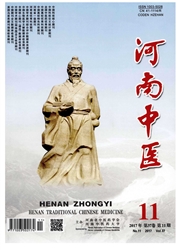

 中文摘要:
中文摘要:
目的:探讨基于肾应冬、肾主骨理论,冬季进行中药干预治疗绝经后骨质疏松症是否存在优势。方法:选取2015年7月至2015年11月北京市朝阳区中医医院收治的绝经后骨质疏松症患者64例,以治疗方法不同分为中药组32例与对照组32例。2组治疗时间均由立冬至大寒节气共75 d,中药组使用二仙汤加减方配合常规治疗,对照组采用常规治疗。观察比较2组治疗前后及随后全年骨降解相关指标,即I型胶原交联N-末端肽、I型胶原交联C-末端肽、降钙素水平变化。结果:治疗后全年随访中,中药组CTX、NTX上升速率低于对照组,但差异不具统计学意义(P〉0.05);另,中药组CT上升速率高于对照组,且于霜降节气2组CT测定值差异有统计学意义(P〈0.05)。结论:冬季择时使用补肾中药治疗绝经后骨质疏松症对于减缓骨降解具有一定效果,与对照组比较结果表明择时用药具有一定临床指导作用。
 英文摘要:
英文摘要:
Objective: To study the effectiveness and advantages of the intervention of Chinese herbal medicine in treating postmenopausal osteoporosis in winter based on the theory of kidney corresponding with the winter and kidney governing bone. Methods:A total of 64 patients with postmenopausal osteoporosis who were admitted and treated in Beijing Chaoyang TCM Hospital from July2015 to November 2015,were divided into Chinese herbal medicine group( 32 cases) and control group( 32 cases). The treatment course for two groups were 75 days from Beginning of Winter( 19 th solar term) to Great Cold( 24 th solar term). Chinese herbal medicine group were treated with modified Erxian Decoction combined with conventional treatment,while the control group were receiving conventional treatment. The changes of bone degradation indexes including Type I collagen cross-linked N telopeptides,type I collagen cross-linked C-terminal telopeptide and calcitonin were observed before and after treatment,as well as in one year.Results: In the annual follow-up visit after treatment,the rising rates of CTX and NTX in Chinese herbal medicine were lowere than that in control group,but the difference was not statistically significant( P 〉 0. 05). The rising rate of CT in Chinese herbal medicine group was higher than that in control group,and the differences of CT level in two groups were statistically significant( P 〈0. 05). Conclusion: Administration of Chinese herbal medicine with kidney nourishment in winter has certain effects on relieving bone degradation. Compared with control group,results show certain guiding significance in clinical practice.
 同期刊论文项目
同期刊论文项目
 同项目期刊论文
同项目期刊论文
 期刊信息
期刊信息
